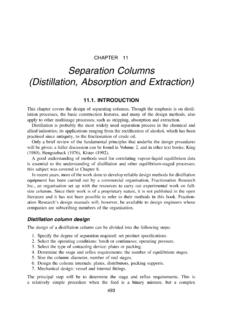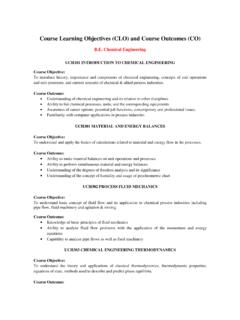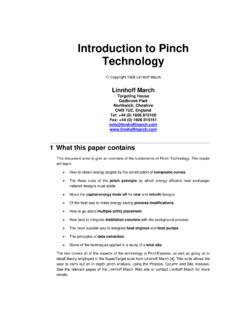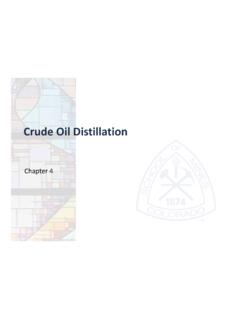Transcription of Ethanol Production by catalytic hydration of ethylene
1 Integrated Project 2019 - 2020 Ethanol Production by catalytic hydration of ethyleneAYAOU Basil BODSON Aude DEHOTTAY Lo c FARAI Rihab FARCY Antoine HENDRICKX DarylLIEGEOIS Thibaut PASTUSZENKO Justine PAULISSEN Sacha RAPPAZZO JulienAbstractThis paper discusses all the aspects of the process of ethylene hydration to produce Ethanol . A short summarygives all the information known and found about the studied process. A erwards, the necessary cost toimplement this process is presented and analyzed. A literature review shows a glimpse of the other kinds ofprocesses used in the industry to produce Ethanol , detailing the catalysts used as well as the di erent rawmaterials. An overview of the Ethanol properties is also displayed in this paper. Finally, the Life Cycle Analysis(LCA) gives the environmental aspect of the ethylene hydration process, underlying sections of the process toimprove such as the heat - Process - ethylene - hydration - LCA - Market - FeedstockContents1 Introduction22 Summary of our process : catalytic hydration Our process.
2 2 Thermodynamics Kinetics and catalysts Reactor Separationprocess Heat integration Costs3 Cost CAPEX .. OPEX .. Cash flows .. 64 Literature hydration of ethylene : Other Processes Comparison with previously obtained results .. Other process: Fermentation .. 9 First generation: Corn Ethanol industry Second generation: Lignocellulosic Ethanol industry Third generation: Algae,Bacteria Feedstock Comparison of all processes .. Ethanol overview .. 11 Market Raw materials uses Toxicity and Environment Recycling Ethanol alternatives In the case of Bioethanol5 Life-cycle assessment (LCA) Raw material supply .. 14 ethylene Transport .. Energy used in the process .. Environmental impacts .. CAPEX costs .. 21 Ethanol Production by catalytic hydration of ethylene 2/211. IntroductionThis project was devoted to the study of Ethanol pro-duction by catalytic hydration of ethylene .
3 A processfor the Ethanol synthesis has been developed and theoperating conditions optimized in order to reduce pro-duction costs. Before the extended literature review, asummary of the work done will be purpose of this extended literature review is tocompare our process with those found in the , the cost of our process will be analyzed. Sec-ondly, our process is compared to similar productionprocesses of synthetic Ethanol using oil-based productsas raw , di erent ways of producing Ethanol willbe discussed and compared to our process. To end thisliterature review, a broader society overview includingmarket, toxicity,.. will be , the LCA of the process will be discussed to ac-knowledge the impacts of the considered Summary of our process : catalytichydration of ethyleneThis process is mainly used to produce Ethanol as asolvent. Considering the entire Ethanol Production , thistype of process represents only 7% of the Production (Roozbehani, Mirdrikvand, Moqadam, & Roshan, 2013;Mohsenzadeh, Zamani, & Taherzadeh, 2017).
4 Indeed, producing Ethanol via this process is more ex-pensive than using techniques such as is due to the price of ethylene , which uctuatesenormously according to the geographical area. Threelarge companies produce synthetic Ethanol : Sasol inSouth Africa, SADAF in Saudi Arabia and Equistar inthe USA. (Roozbehani et al., 2013). Our processThe process displayed in theFigure8 was the subject ofan in-depth study this year. The following equilibriumdescribes the main reaction:C2H4+H2O C2H5 OHBecause of the equilibrium, the operating conditionsplay an important role in conversion. Part of the workdone this year was useful to determine the optimal con-ditions for a maximized conversion, taking into accountthe imposed constraints. However, ones must be carefulabout the fact that other components are present in theprocess due to impurities in the ethylene 1 Our process ThermodynamicsThe thermodynamics part was devoted to determinethe properties of all the components of our reach this goal, the properties for the pure compo-nents at di erent temperatures and pressures have tobe determined.
5 Then, the properties of ideal and realmixtures can be found. The real mixture propertieswill depend on the choice of the thermodynamic data will be used in the other sections for thedesign of all unit operations. In this way, concerningthe pure components, the Peng-Robinson model waschosen to describe them. For the mixtures, the modelthat ts the better the experimental data of binary mix-tures was chosen. For this case, the NRTL-RK is themost accurate Kinetics and catalystsThree main reactions are occurring within the studiedprocess: ethylene hydration :C2H4+H2Or1 r2C2H5 OHwithr=r1 r2=k1 pE pW k2 KA pA{1+KE pE+KW pW+KA pA+KDEE pDEE}2 Ethanol Production by catalytic hydration of ethylene 3/21 Ethanol dehydration:2C2H5 OHr3 r4H2O+(CH3CH2)2 Owithr=r3 r4=k3 p2A k4 pW pDEE{1+KW pW+KA pA+KE pE+KDEE pDEE}2 Acetylene conversion into acetaldehyde:C2H2+H2Or5 CH3 CHOwithr=r5=k5 pAcetyleneIn the kinetics and catalyst part, it was rst shownthat with Langmuir Hinshelwood reaction mechanisms,it was possible to nd back the reaction rates of gas-phase hydration of ethylene , Ethanol dehydration andacetylene conversion into acetaldehyde.
6 Then, it hasbeen demonstrated, for the chosen operating conditions,that the limiting step of ethylene hydration was thechemical reaction and not the di usion has therefore been shown that the catalyst operatesin chemical regime. It also has been proven that thecatalyst could be considered as isothermal. Based onthis, the design of the process reactor as isothermaland the use of chemical rates were ReactorIn the reactor part, the main reaction that occurs is theone that leads to the Production of Ethanol as mentionedpreviously:C2H4+H2O C2H5 OHIn order to design the reactor correctly, the reactor hadto be numerically modeled in the software Aspen sothat the in uence of the parameters such as the pres-sure, the temperature and the steam to ethylene ratiocan be goal is to maximize the conversion of the mainethylene reaction by determining the optimal condi-tions. The other two undesired reactions leading tothe formation of the diethylether and acetaldehyde donot have a signi cant conversion variation when theparameters of the reactor are varied.
7 Thanks to theoptimizing tool of Aspen, the parameters converged tothe optimal parameters and it had to be veri ed thatthe results make sense by performing many sensitivityanalysis. The nal reactor parameters obtained are thefollowing: at the 1 Operating conditions of the reactorThe operating conditions shown in the Table 1 were xed such that there is only a vapor phase in the the temperature decreases or if the steam-to-ethyleneratio is higher than , the liquid phase will start form-ing. Increasing the pressure above atm will not leadto a signi cant and interesting increase in the conver-sion. Additionally to that, it would increase signi cantlythe cost of the type of reactor considered is an isothermal plug owreactor. Because knowing that the reaction is exother-mic, if an adiabatic reactor was chosen, this will lead toan increase of temperature in the reactor, leading to adecrease of conversion due to the kinetics.
8 Also the totalvolume of the reactor considered is about 620m3witha bed void fraction of The maximum ethyleneconversion obtained is about 10%. In order to respectthe design of a typical tubular reactor, the length overdiameter ratio should be at least equal to 5. Additionallyto that, the pressure drop has a negligible in uence onthe conversion. Which means the length of the reactordoesn t matter as long as the total nal chosen volumeis Separation processThe separation process is composed of a ash unit aswell as a distillation column. The purpose of the ashunit is to separate Ethanol as well as water from theother undesired components like ethane, methane,.. Ethanol Production by catalytic hydration of ethylene 4/21 Concerning the other unit, the distillation column aimedto obtain the Ethanol at the desired purity 82 molar%and therefore, its main goal was to eliminate most ofthe ash was designed in order to get a liquid outlet bigenough to meet our quantity speci cations.
9 Indeed, 30000 tonnes of Ethanol at 82 molar% purity were requiredper year. The varied parameter was the temperature in-side the ash as it determines the ratio between vapourand liquid outlets. The optimal working temperature is85 distillation column was designed in multiple steps,as this unit is much more complex than the latter rst, short-cut methods were used to get an order ofmagnitude of the column parameters, the numberof stages, the feed stage position, the re ux ratio, thereboiler heat duty and the tray McCabe-Thiele method was then used to re ne , the last step consisted in implementing the dis-tillation column on Aspen as well as the ash unit. This nal step was useful to know the true composition atthe inlet of both units allowing even more precise each of the steps mentioned, the optimal columnwas chosen to minimise the costs related to that sep-aration unit. The costs comprise the equipment costand the utility cost.
10 By analysing the in uence of thecolumn parameters, it has been understood that thetwo main parameters in uencing the most the costs arethe re ux ratio and the reboiler duty. Decreasing theseparameters led to a decrease of the utility cost, whichis the main fraction of the total , one has to be careful that this decrease of there ux ratio and the reboiler duty has a limit as it mayinduce a possible dry up within the the combination minimising the re ux ratio andreboiler duty values, the number of theoretical stageshas been set in order to meet the desired speci cationsin quantity as well as in ux ratioReboiler dutyNumber of kW31 Table 2 Optimal parameters of the Heat integrationThe aim of the heat integration is to minimise the energyconsumption of the process. Once the di erent parts ofthe process have been optimised, the streams and theunits that need to be heated or cooled are identi ed andcoupled in heat pinch analysis allows to determine the hot and coldutilities that are still needed: for the hotutility and for the cold one.






